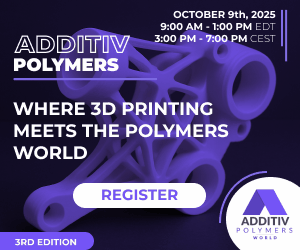 A flower curls in on itself as though responding to the setting of the sun. A pattern of diamonds expands and contracts like a gate opening and closing. A flat pattern arches into a dome. All of these objects are 3D printed, and yes, they all move and change shape – which makes them 4D printed, technically. We’ve written about 4D printing before, but the objects printed by researchers at the Georgia Institute of Technology, Singapore University of Technology and Design, and Xi’an Jiaotong University are a little bit different from most of the other 4D printed objects we’ve seen before.
A flower curls in on itself as though responding to the setting of the sun. A pattern of diamonds expands and contracts like a gate opening and closing. A flat pattern arches into a dome. All of these objects are 3D printed, and yes, they all move and change shape – which makes them 4D printed, technically. We’ve written about 4D printing before, but the objects printed by researchers at the Georgia Institute of Technology, Singapore University of Technology and Design, and Xi’an Jiaotong University are a little bit different from most of the other 4D printed objects we’ve seen before.
The researchers at the three institutions created their objects by 3D printing them from multiple reactive materials, each designed to respond differently to a heat stimulus. For example, a flower with several layers of petals curls up like a real flower, with the inner ring of petals completely closing up, and successive rings bending more slightly.
“This new approach significantly simplifies and increases the potential of 4-D printing by incorporating the mechanical programming post-processing step directly into the 3-D printing process,” said Jerry Qi, a professor in the George W. Woodruff School of Mechanical Engineering at Georgia Tech. “This allows high-resolution 3-D printed components to be designed by computer simulation, 3-D printed, and then directly and rapidly transformed into new permanent configurations by simply heating. The approach can achieve printing time and material savings up to 90 percent, while completely eliminating time-consuming mechanical programming from the design and manufacturing workflow.”
 The objects were 3D printed on a Stratasys Objet500 Connex3. The heat stimulus was applied in the form of simple hot water. Examples included a lattice shape that, when immersed in the hot water, expanded to nearly eight times its original size. When placed in cold water, it retracted back to its original shape and size.
The objects were 3D printed on a Stratasys Objet500 Connex3. The heat stimulus was applied in the form of simple hot water. Examples included a lattice shape that, when immersed in the hot water, expanded to nearly eight times its original size. When placed in cold water, it retracted back to its original shape and size.
“Our composite materials at room temperature have one material that is soft but can be programmed to contain internal stress, while the other material is stiff,” said Zhen Ding, a postdoctoral researcher at Singapore University of Technology and Design. “We use computational simulations to design composite components where the stiff material has a shape and size that prevents the release of the programmed internal stress from the soft material after 3-D printing. Upon heating the stiff material softens and allows the soft material to release its stress and this results in a change – often dramatic – in the product shape.”
The technology could lend itself to a number of commercial applications. For example, items could be flattened or rolled for shipping, and then expand to their final shapes once in use. Eventually, the technology could be developed to a point at which the materials could be designed to respond to stimuli such as temperature, moisture or light in a timed way that would allow for everything from deployable medical devices to expandable outer space structures.
“The key advance of this work is a 4-D printing method that is dramatically simplified and allows the creation of high-resolution complex 3-D reprogrammable products,” said Martin L. Dunn, a professor at Singapore University of Technology and Design and the director of the SUTD Digital Manufacturing and Design Centre. “It promises to enable myriad applications across biomedical devices, 3-D electronics, and consumer products. It even opens the door to a new paradigm in product design, where components are designed from the onset to inhabit multiple configurations during service.”
The research was published in a paper entitled “Direct 4D printing via active composite materials,” which you can read here. Authors include Zhen Ding, Chao Yuan, Xirui Peng, Tiejun Wang, H. Jerry Qi, and Martin L. Dunn. Discuss in the 4D Printing forum at 3DPB.com.
Subscribe to Our Email Newsletter
Stay up-to-date on all the latest news from the 3D printing industry and receive information and offers from third party vendors.
Print Services
Upload your 3D Models and get them printed quickly and efficiently.
You May Also Like
3D Printing News Briefs, September 17, 2025: IDEX Printer, NiTi Scaffolds, Cooking Oil, & More
In today’s 3D Printing News Briefs, Raise3D announced the launch of a new printer at FABTECH 2025, and EOS and AM Solutions share about their integrated post-processing ecosystem, first introduced...
PostProcess Technologies Offers Automated Resin Removal for the Stratasys Neo800+
PostProcess Technologies has paired its DEMI 4100 automated resin removal system with the Stratasys Neo800+. The Neo is a line of workhouse vat polymerization systems long loved by Formula 1...
3D Printing News Briefs, September 13, 2025: Automated Post-Processing, Stratospheric Probe, & More
In this weekend’s 3D Printing News Briefs, we’re first sharing about a case study from PostProcess Technologies about optimizing post-print workflows at J.W. Speaker. AM Solutions’s post-processing technology was used...
Printing with Peace of Mind: UltiMaker Launches Secure Line of 3D Printers
As the defense sector continues to adopt additive manufacturing (AM) amidst a backdrop of continuing supply chain pressure and global conflicts, it’s more critical than ever to ensure cybersecure production...



































